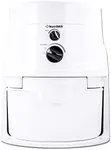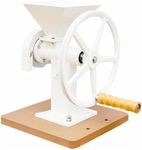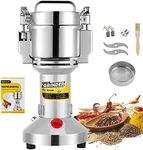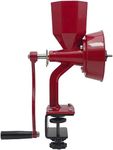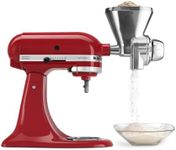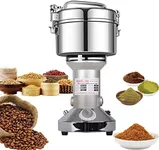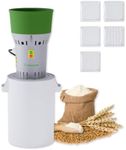Buying Guide for the Best Home Flour Mills
Choosing a home flour mill can be a rewarding decision if you want to enjoy fresh, nutritious flour for baking and cooking. The right mill will depend on your baking habits, the types of grains you want to process, and how much flour you need at a time. Understanding the key features will help you find a mill that fits your kitchen and your lifestyle.Type of Mill (Manual vs. Electric)Home flour mills come in manual (hand-cranked) and electric versions. Manual mills require physical effort and are quieter, making them suitable for small batches or occasional use. Electric mills are faster and more convenient for frequent or large-scale baking, but they need a power source and can be noisier. If you bake often or in large quantities, an electric mill is usually more practical, while a manual mill is great for those who value portability or want to use it off-grid.
Grinding Mechanism (Stone, Burr, or Impact)The grinding mechanism determines how the mill crushes the grain. Stone mills use natural or synthetic stones and are known for producing fine, cool flour, which helps preserve nutrients. Burr mills use metal or ceramic plates and offer consistent texture, while impact mills use high-speed blades for very fine flour but can generate more heat. If you want the most nutritious flour and bake a variety of breads, stone or burr mills are ideal. Impact mills are best for those who need superfine flour quickly, such as for cakes or pastries.
Grain CompatibilityNot all mills can handle every type of grain or seed. Some are designed for soft grains like wheat, while others can process harder grains, beans, or even oily seeds. Check the mill’s compatibility with the grains you plan to use most often. If you want to experiment with a wide range of grains, look for a versatile mill that can handle both hard and soft varieties.
Flour Fineness SettingsThis feature allows you to adjust how fine or coarse the flour will be. Some mills offer a wide range of settings, while others have just a few. If you like to bake different types of bread, pastries, or even cracked grains for cereals, a mill with multiple fineness settings will give you more flexibility. If you mostly bake one type of bread, a simpler mill may suffice.
Capacity and Output SpeedCapacity refers to how much grain the mill can process at once, and output speed is how quickly it produces flour. Smaller mills are suitable for occasional use or small households, while larger mills are better for frequent bakers or bigger families. Consider how much flour you typically need and how quickly you want to produce it to choose the right size and speed.
Ease of Cleaning and MaintenanceFlour mills can accumulate residue, so easy cleaning is important for hygiene and performance. Some mills have removable parts or self-cleaning features, while others require more effort to maintain. If you plan to use your mill often or with different grains, look for a model that’s easy to take apart and clean.
Noise LevelElectric mills, especially impact types, can be quite loud, while manual mills are much quieter. If you have a sensitive household or plan to use the mill early in the morning or late at night, consider the noise level as part of your decision.
Size and StorageHome flour mills can be bulky, so consider the available space in your kitchen. Some mills are compact and easy to store, while others are larger and may need a dedicated spot. Think about where you’ll keep the mill and how often you’ll need to move it.



